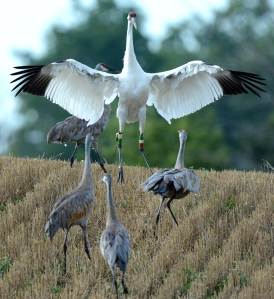How can you tell the difference between the endangered Whooping Crane (under 400 wild birds left ON THE PLANET and Kansas is a place where you can see them) and the more common Sandhill Crane ? Both species use the Central Flyway over Kansas during their migration, particularly preferring the wetlands of central Kansas, and the two species may even fly or be seen on the ground together.
While both species have long necks, long, black legs, and long, straight bills (they are both crane species after all), there are some key but sometimes subtle differences. Here’s what to look out for:
Size

Whooping crane with sandhill cranes. Photo by USFWS Midwest
Whooping Crane: The tallest of North America’s birds can be around 5 foot tall and with a 7 to 8 foot wing span.
Sandhill Crane: Still big, but around 4.5 foot tall max and with a 6.5 foot wing span.
Color
Whooping Crane: Adults are mostly a bright white with a red face. The black wingtips that can be seen only when the wings are extended.
Juveniles have a rusty, cinnamon color to their body and wings. — This is what can be tricky — without the characteristic size and color of the adults, a juvenile Whooping Crane could be thought to be another species.
Sandhill Crane: Adults are a slate gray with a small red cap.
Juveniles may have reddish, rusty feathers on their body but won’t yet have the red on their heads.
